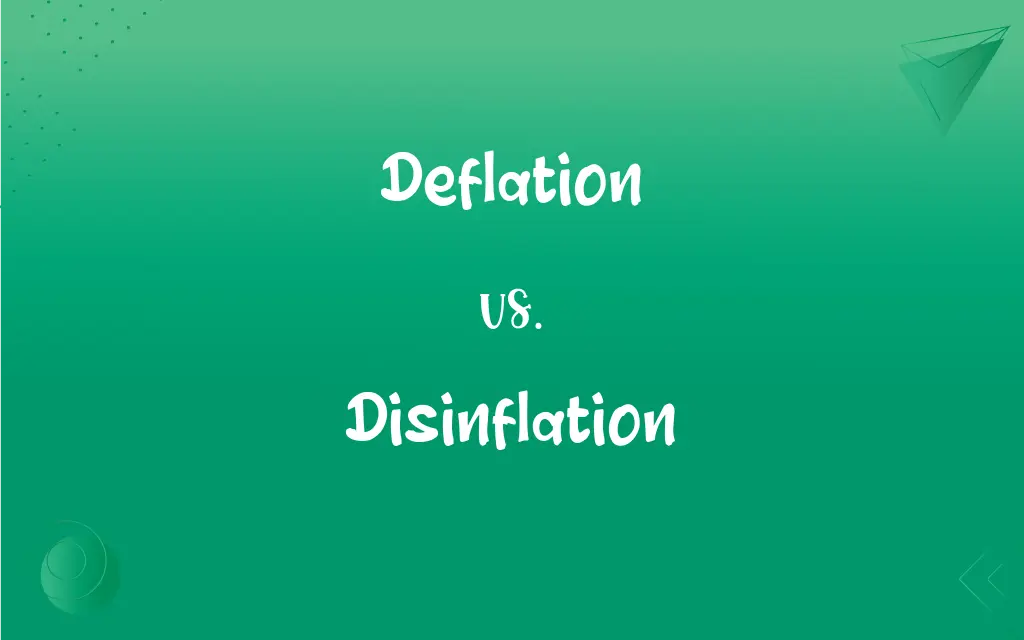Deflation vs. Disinflation: What's the Difference?
Edited by Aimie Carlson || By Janet White || Published on November 30, 2023
Deflation is a decrease in the general price level, while Disinflation is a slowdown in the rate of inflation.

Key Differences
Deflation and Disinflation, while both related to price movements, depict different economic phenomena. Deflation refers to the decline in the overall level of prices in an economy. When Deflation occurs, consumers might postpone purchases, expecting prices to drop further, which can lead to decreased production and increased unemployment. On the other hand, Disinflation indicates a reduction in the inflation rate over a specific period. While inflation still occurs during Disinflation, its pace is slower.
Economically, Deflation can be more concerning than Disinflation. Persistent Deflation can lead to a deflationary spiral where reduced demand leads to lower prices, which in turn results in lower production, culminating in layoffs and further reduced demand. Conversely, Disinflation, especially when it's a result of productivity improvements or reduced costs of inputs, can be seen as a positive sign, indicating an efficient economy.
It's important to understand that while Deflation is a negative inflation rate, Disinflation still implies positive inflation, albeit at a decreasing rate. For example, if the inflation rate drops from 5% to 3%, it's Disinflation, but if the general price level drops by 2%, it's Deflation.
Central banks often have tools to combat both Deflation and Disinflation. In the face of Deflation, a central bank might opt for expansionary monetary policies to boost demand. When addressing Disinflation, central banks might assess whether the slowing inflation is due to transient factors or if it necessitates a policy response.
Finally, it's pivotal for policymakers to distinguish between Deflation and Disinflation. The remedies for Deflation, such as stimulating economic demand, might not be apt for Disinflation, where the focus might be more on ensuring the inflation rate doesn't drop too low, jeopardizing economic stability.
ADVERTISEMENT
Comparison Chart
Definition
Decrease in general price level.
Slowdown in the rate of inflation.
Price Movement
Prices are falling.
Prices are rising, but at a slower rate.
Inflation Rate
Negative inflation rate.
Positive inflation rate but decreasing.
Economic Implication
Can lead to reduced demand and unemployment.
Indicates efficient economy or transient factors.
Central Bank Response
Expansionary policies to stimulate demand.
Evaluate causes and ensure stability.
ADVERTISEMENT
Deflation and Disinflation Definitions
Deflation
A general decline in prices across an economy.
During the Great Depression, Deflation caused many to delay purchases.
Disinflation
Positive inflation rate but at a declining pace.
The economy experienced Disinflation as inflation dropped from 4% to 2%.
Deflation
Negative growth in the inflation rate.
Japan faced periods of Deflation in the 1990s.
Disinflation
A period where inflationary pressures are receding.
The 1980s in the U.S. saw periods of Disinflation.
Deflation
Reduction in the overall price level, leading to increased real value of money.
Persistent Deflation can harm an economy's growth.
Disinflation
A decrease in the rate at which prices increase.
The central bank's measures resulted in Disinflation, stabilizing the economy.
Deflation
Opposite of inflation, indicating falling prices.
Central banks often employ strategies to combat Deflation.
Disinflation
Slowing down of inflation without turning negative.
Disinflation can be a sign of an efficient market response.
Deflation
The act of deflating or the condition of being deflated.
Disinflation
Reduction in inflation rate over a particular timeframe.
Policymakers were relieved to notice Disinflation after a period of high inflation.
Deflation
A persistent decrease in the level of consumer prices or a persistent increase in the purchasing power of money.
Disinflation
A marked deceleration in the rate of inflation.
Deflation
The lifting and removal of small, loose particles, especially silt and clay particles, by eddies of wind.
Disinflation
(economics) A decrease in the inflation rate.
Deflation
An act or instance of deflating.
The loss caused utter deflation and disappointment among the fans.
Disinflation
(economics) Deflation
Deflation
(economics) A decrease in the general price level, that is, in the nominal cost of goods and services as well as wages.
Disinflation
A reduction in the rate of price increases; a lessening of inflationary pressure.
Deflation
An economic contraction.
Disinflation
A reduction of the value of a currency in international exchange markets caused by a government; - usually done as a means to improve the country's international balance of payments.
Deflation
(geology) The removal of soil and other loose material from the ground (or another surface) by wind, leaving it exposed to erosion.
Disinflation
A general and progressive increase in prices;
In inflation everything gets more valuable except money
Deflation
The act or process of deflating.
Deflation
A fall in the average prices of goods and services; - usually associated with contraction of economic activity. Opposite of inflation. Compare disinflation.
Deflation
The reduction of available credit or a contraction of economic activity resulting from or associated with a decline of prices.
Deflation
The act of letting the air out of something.
Deflation
The erosion of land structures such as sand or soil due to the action of wind.
Deflation
(geology) the erosion of soil as a consequence of sand and dust and loose rocks being removed by the wind;
A constant deflation of the desert landscape
Deflation
A general and progressive increase in prices;
In inflation everything gets more valuable except money
Deflation
The act of letting the air out of something
Deflation
A situation where the inflation rate goes below zero percent.
Deflation can result in increased unemployment rates.
FAQs
What is Deflation?
Deflation is a decrease in the general price level across an economy.
Does Deflation mean negative inflation?
Yes, Deflation implies a negative inflation rate.
How is Disinflation defined?
Disinflation is a slowdown in the rate of inflation.
Can an economy experience Disinflation and still have rising prices?
Yes, during Disinflation, prices rise but at a slower pace.
How can Deflation impact consumers?
Consumers might delay purchases, expecting further price reductions.
Is Disinflation bad for the economy?
Not necessarily, it depends on the causes and its degree.
What might cause Deflation in an economy?
Reduced demand, increased supply, or technological advancements can lead to Deflation.
How can central banks address Disinflation?
They can evaluate its causes and ensure inflation doesn't drop too low.
Which is more concerning, Deflation or Disinflation?
Deflation is generally more concerning due to its potential adverse effects on the economy.
Can an economy recover from Deflation?
Yes, with appropriate monetary and fiscal policies.
How does Deflation affect debt?
Deflation can increase the real value of debt, burdening borrowers.
Can Deflation lead to an economic recession?
Yes, if persistent, Deflation can depress demand and lead to a recession.
Is Disinflation always intentional?
No, it can be both a natural economic outcome or a result of policy decisions.
Can Disinflation transition into Deflation?
Yes, if the slowing inflation eventually turns negative.
How can businesses be affected by Deflation?
Reduced consumer demand can lead to decreased profits and potential layoffs.
Is Disinflation the same as no inflation?
No, Disinflation means a slower rate of inflation, not its absence.
What causes Disinflation?
Factors like reduced demand, increased supply, or central bank actions can cause Disinflation.
What's the relation between Disinflation and interest rates?
Disinflation might lead to lower interest rates if central banks seek to stimulate demand.
Does Deflation benefit savers?
Yes, the real value of savings can increase in a deflationary environment.
Do central banks target Disinflation?
Sometimes, especially if inflation rates are perceived as too high.
About Author
Written by
Janet WhiteJanet White has been an esteemed writer and blogger for Difference Wiki. Holding a Master's degree in Science and Medical Journalism from the prestigious Boston University, she has consistently demonstrated her expertise and passion for her field. When she's not immersed in her work, Janet relishes her time exercising, delving into a good book, and cherishing moments with friends and family.
Edited by
Aimie CarlsonAimie Carlson, holding a master's degree in English literature, is a fervent English language enthusiast. She lends her writing talents to Difference Wiki, a prominent website that specializes in comparisons, offering readers insightful analyses that both captivate and inform.






































































